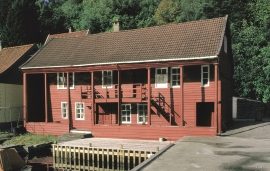Published: 30.01.2013 | Author: Nils Georg Brekke, Anders Bjarne Fossen
Strusshamn at the beginning of the 1800s. Pen and ink drawing by J.F.L.Dreier. (owner: Universitetsmuseet i Bergen).
On the south side of Askøy, just west of Bergen, lies Strusshamn. The sheltered bay is one of the best harbours in Byfjorden, on the route south. At the time of the sailing ships the harbour could be full of vessels from Bergen and abroad, lying in wait for favourable wind. Old anchoring rings from 1687 bear witness to this. Strusshamn was a quarantine harbour for ships that came sailing in with the yellow pest flag flying.
After the law of 1648 was passed on “Skydsfærd til Lands og Vands, samt Gjæstgiverier i Norge” (Transport on Land and on Sea as well as Guesthouses in Norway) a guesthouse locality was also established here. The main building, which probably dates from the 1700s stood until 1993, altered and reconstructed with an aura of old grandeur. The building had a freestanding row of columns over two storeys at the main façade, but in the pen and ink drawing by J.F.L. Dreier we see the guesthouse with a large hipped roof beside a boathouse, which no longer exists today. At the guesthouse place there was a lively exchange of goods, and figures entered into the medical reports on venereal disease are the highest in Søndre Bergenhus County.
The first church was built here in 1741, as an annex church to the Cathedral. Laksevåg and Loddefjord belonged under Strusshamn parish; Loddefjord right up to 1915. The old church in Strusshamn burned down in 1861, but it was re-erected in 1864, further south. This church also burned down in 1966, and was reconstructed in 1969.
The industrial community of Strusshamn
In 1804 Hans Nielsen Hauge and his friends set up millworks in Strusshamn, and through the 1800s the guesthouse owner was at the same time head of the millworks. The mill became a key business for milling corn from the Baltic Sea imported by the Bergen merchants. As were the five other Askøy mills, the mill in Strusshamn was also managed by master millers from Bergen. When the shipyard owner Rasmus Rolfsen from Elsero bought the mill in 1879,he inserted a turbine in place of the old water wheel. In 1909 the Bergen Company, M.G.Riisøen closed down the mill and sold the buildings and water rights to Arne Johannessen, who moved his shoddy factory there from Årstad. For many years this was a cornerstone enterprise in the municipality, one of the foremost in Scandinavia within its field. The production was closed down in the 1980s.
Strusshamn kirke
Strusshamn was a church centre and the natural gathering place for a large hinterland. The picture shows the church that was built in 1864.(photo: O. Schumann Olsen, owner: Billedsamlingen, Universitetsbiblioteket i Bergen (S.O. 939)).






